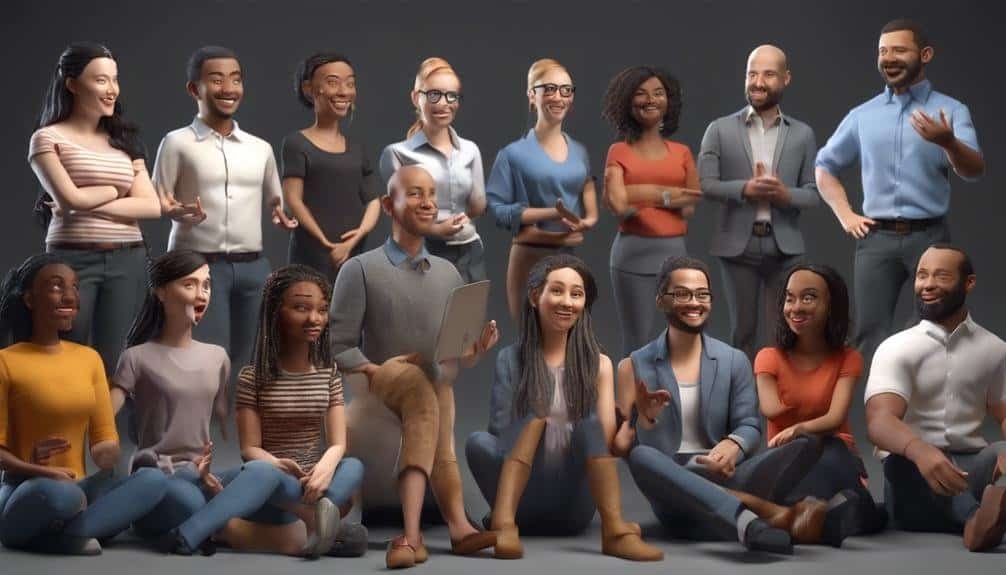Communication Strategies for Neurodiverse Minds: Navigating Conversations and Relationships
Engaging in conversations with neurodiverse minds involves embracing diversity. Listen attentively by reflecting thoughts and mirroring emotions. Nonverbal cues like eye contact show respect. Be clear and succinct in your communication, breaking down instructions. Empathy and perspective-taking are key; understanding emotions fosters connections. Establish boundaries, communicate openly, and respect differences. These strategies promote inclusivity and understanding, leading to richer relationships. Explore deeper insights into effective communication for neurodiverse minds.
Key Takeaways
- Practice active listening techniques like reflective listening and mirroring emotions.
- Use clear and concise communication to avoid misunderstandings.
- Cultivate empathy and perspective-taking for better understanding.
- Establish boundaries, respect differences, and encourage open communication.
- Foster trust through reliability, consistency, and acceptance of diverse communication styles.
Understanding Neurodiversity
To better communicate effectively with neurodiverse individuals, it's important to first understand the diverse ways in which their minds perceive and process information. Neurodiversity awareness plays an essential role in creating inclusive communities where everyone feels valued and understood.
Neurodiverse individuals encompass a wide range of cognitive differences, including autism, ADHD, dyslexia, and more. Embracing neurodiversity means recognizing that these differences are a natural part of the human experience. By fostering neurodiversity awareness, we can promote acceptance and appreciation for the unique strengths and perspectives that neurodiverse individuals bring to our communities.
Inclusive communities aim to create environments where all individuals, regardless of their neurodiversity, feel welcome and supported. This involves accommodating diverse communication styles, providing necessary resources, and offering understanding and patience in interactions. By embracing neurodiversity and promoting inclusivity, we can build stronger, more empathetic communities where everyone has the opportunity to thrive.
Active Listening Techniques
Engage fully in conversations with neurodiverse individuals by employing active listening techniques that demonstrate your genuine interest in understanding their perspectives. Reflective listening, such as paraphrasing what they've said to show you're actively processing their words, can help them feel heard and valued. Mirroring their emotions or summarizing key points shows that you're engaged and attentive.
Nonverbal cues and body language play an essential role in active listening. Maintaining eye contact shows respect and attentiveness, while nodding or using facial expressions can indicate your understanding and encouragement. Be mindful of your own body language, ensuring it conveys openness and receptiveness to foster a comfortable environment for sharing thoughts and feelings.
Clarity in Communication
For clearer communication with neurodiverse individuals, make sure your messages are straightforward and easily understood. When providing instructions, break them down into clear steps to avoid confusion. Use concise language and avoid unnecessary details that could lead to overwhelm.
Effective communication also involves giving feedback that's specific and constructive. When offering feedback, focus on the behavior or action that needs addressing, and provide suggestions for improvement in a supportive manner. Remember to be patient and allow time for processing information, as neurodiverse individuals may need extra time to understand and respond.
Empathy and Perspective-Taking
Understanding the emotions and perspectives of neurodiverse individuals is key to fostering meaningful connections and effective communication. Empathy exercises can help you develop a deeper understanding of how others feel, even when their experiences differ from your own. By practicing active listening and putting yourself in someone else's shoes, you can create a more inclusive and supportive environment for neurodiverse individuals. Perspective challenges may arise when trying to see things from a different point of view, but these challenges are opportunities for growth and learning.
| Empathy Exercises | Benefits | Tips |
|---|---|---|
| Practice active listening | Enhances understanding | Focus on the speaker |
| Reflect on others' emotions | Builds connections | Validate feelings |
| Engage in role-playing scenarios | Improves communication | Be open-minded |
Establishing Boundaries and Respect
Setting clear boundaries and showing respect are essential aspects of effective communication with neurodiverse individuals. When interacting with someone neurodiverse, keep these key points in mind:
- Setting limits: Clearly communicate your boundaries, whether it's about personal space, topics of conversation, or sensory sensitivities. This helps establish a sense of safety and predictability in the interaction.
- Building trust: Demonstrate reliability by following through on commitments and being consistent in your actions and words. Trust forms the foundation of any relationship and is especially important when communicating with neurodiverse individuals.
- Respecting differences: Acknowledge and accept the unique traits and perspectives of the neurodiverse individual. Embrace diversity in communication styles and be open to learning from each other.
- Encouraging open communication: Create a safe and supportive environment where both parties feel comfortable expressing their thoughts and feelings. Encourage open dialogue and active listening to foster understanding and mutual respect.
Conclusion
You've now mastered the art of communication with neurodiverse minds!
By actively listening, being clear in your communication, practicing empathy, and setting boundaries, you've discovered the key to successful relationships.
Your newfound skills won't only benefit those around you, but also enhance your own understanding and connection with others.
Keep practicing and watch your relationships flourish like never before!








